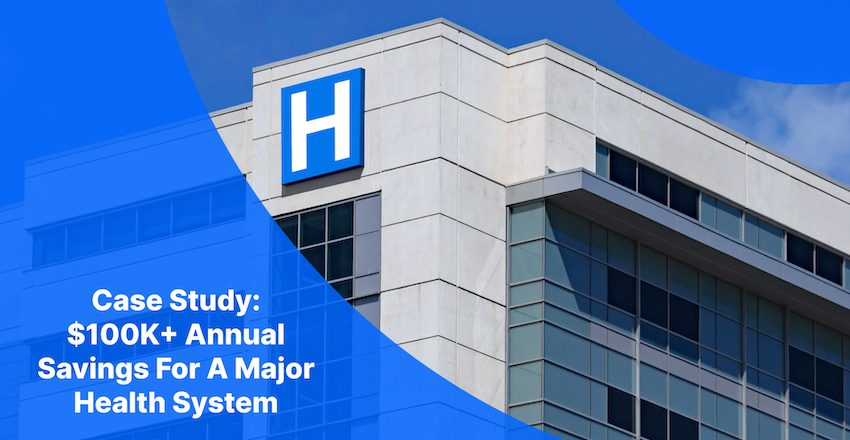How a PocketHealth Community Gateway Enables Seamless Image Sharing Between Guadalupe Regional Medical Center (GRMC) and Methodist Hospital
January 8, 2024
Read More
Find a secure and universal image-sharing solution and move away from a fragmented system consisting of legacy image exchange, VPNs and burning CDs.
In order to make imaging records accessible to patients and providers across the region, this large healthcare system had a siloed and inefficient system that included a legacy image exchange, VPNs and CD burning. These limitations and inefficiencies needed to be addressed.
The hospital network, which performs more than 200,000 radiology exams annually, used a legacy image exchange for image sharing with nearby facilities that also used that network. But for facilities without the legacy image exchange, the organization used a network of individual VPNs. This point-to-point sharing with external hospitals and providers had its drawbacks. VPN connections had unreliable security protocols, required significant IT investment from both providers and not all users had the necessary training or logins.
When VPN sharing wasn’t possible, staff resorted to CD burning—a resource-intensive practice that hindered data accessibility and created a negative experience for patients, most of whom no longer owned computers with CD drives.
As well, access to relevant prior imaging was limited. Clerical staff spent time tracking down priors, patients had to be rescheduled and oftentimes, the priors couldn’t be retrieved. CDs would go missing, which would subsequently produce delays in care, undermining patient satisfaction.
If a patient wanted access to their imaging, they had to physically travel to the clinic to sign a release and obtain a copy of their scans. These requests took time and required staff involvement from multiple departments like Medical Records, Radiology and IT.
Leaders at the health system were not just thinking about their own local patient community, but rather the wider communities across the state and nearby states. In this region, it’s not uncommon for patients to cross state lines to receive care. The health system wanted to be a cooperative partner and provide patients with a frictionless experience.
With these disconnected solutions to sharing medical imaging records, the organization sought out a more cohesive system.
The health system adopted the PocketHealth for Patients and PocketHealth for Providers solutions to leverage the platform’s full capabilities, allowing patient and provider sharing, both in- and out-of-network.
PocketHealth was fully implemented and driving results, within two months. Leadership and staff at the organization appreciated how little time it took to complete all the technical and operational work needed to integrate the platform.
To support change management, PocketHealth held virtual and in-person training for all staff involved in patient medical record access requests. Additionally, PocketHealth supplied a range of communication assets in English and Spanish—both physical (e.g., posters, signs, handouts) and digital (e.g., website copy, social media posts). The team even came on-site to distribute and post these materials at no additional cost.
Once implemented, PocketHealth was able to rapidly fulfill patient imaging record requests by providing authenticated patients with timely web access to their records. PocketHealth for Patients enabled patients to share imaging directly with their doctors and use secure digital image release to share with out-of-network providers, eliminating the need for VPNs and intervention by clerical staff.
As well, PocketHealth offers PocketHealth for Providers, enabling the health system imaging providers to transfer DICOM imaging files and radiology reports to other healthcare providers more efficiently. This simplifies record sharing and retrieval workflows and reduces administrative workload.
The organization is saving an estimated $100K in annual costs, reducing lead times for retrieving and sharing priors and they have also significantly reduced CD-burning.
Whether it was through the legacy image exchange, VPNs or CDs, the imaging workflow involved departments beyond radiology. PocketHealth’s seamless integration with PACS enables the automatic upload of imaging to the cloud, making it available for patients upon request. Not only does this eliminate clerical intervention, it also gives patients the freedom to share their imaging with their doctors and family members instantly.
Eliminating VPNs saved hundreds, if not thousands, of hours of IT time and improved cybersecurity for image sharing. With the integration of PocketHealth, they saw a 90% reduction in CDs burned—a major tightening in efficiency. The easy online patient sign-up flow and instant record access also meant patients no longer had to physically visit sites to get copies of their scans and clerical staff weren’t spending time managing the release of these records.
Referring physician adoption was a focus during implementation and the response has been positive, with more than 170 access pages accepted by physicians weekly.
But the greatest impact is to the bottom line. The previous processes involved hefty hard and soft costs. For instance, when it came to CD burning, every line item, from packaging, software, equipment and shipping, added up to over $45,000 annually, which is now being saved.
More importantly, the estimated soft cost savings surpasses the CD costs. Reduced manual processes and the elimination of CDs are also saving the organization over 80 staff hours per month. The hours spent retrieving, sending and authorizing the release of imaging records add strain to staff across departments like radiology, health records, IT, logistics and more.
Implementing PocketHealth has delivered results quickly and helped the organization to make progress against high-priority goals. The implementation generated savings, improved patient experiences and eliminated administrative work, allowing staff to focus on higher-impact tasks. In total—hard costs combined with soft costs—the organization is realizing savings of well over $100,000 annually. Patients are having better experiences and they are empowered to be active participants in their care because they now have fast and easy access to their imaging reports. Employees have more time to spend on patients, and in a time of staffing shortages, having those hours back will give staff more time to focus on quality of care and outcomes.